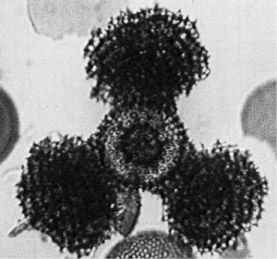 Lithocyclia
aristotelis (Ehrenberg) group
Lithocyclia
aristotelis (Ehrenberg) group Lithocyclia
aristotelis (Ehrenberg) group
Lithocyclia
aristotelis (Ehrenberg) groupAstromma aristotelis Ehrenberg, 1847b, p.55, fig.10
Lithocyclia aristotelis (Ehrenberg) group, Riedel and Sanfilippo, 1970, p.522, pl.13, figs.1-2
This species-group name is used for a number of forms with skeletons similar to those of the L. ocellus group, but with separated spongy arms rather than a continuous spongy zone around the phacoid shell. In the group are included forms with three or four (or more?) arms, with or without terminal spines, and with or without a patagium (Riedel and Sanfilippo, 1970).
From the margin of the phacoid shell arise three or four wide spongy arms, with or without terminal spines (Riedel and Sanfilippo, 1978a).
Members of this group differ from their descendants, Lithocyclia angusta and L. crux, by the arms being generally wider, not tapering distally, and never exhibiting marked longitudinal structure. From co-occurring species of Stephanastrum, wherein the central structure to which the arms are attached has a diameter of only 55-70 µm. The Lithocyclia aristotelis group differs in having a larger cortical shell (Sanfilippo et al., 1985).
Under this name are grouped a great variety of forms with a distinct cortical shell enclosing a double medullary shell, and three or four arms with or without terminal spines and with or without a patagium. The cortical shell usually has a diameter of 90-120 µm (occasionally as small as 75 µm), and the arms maintain the same breadth throughout their length or expand distally. The arms are sometimes irregularly spongy throughout, sometimes concentrically zoned in their proximal part or their entire length (Sanfilippo et al., 1985).
This species group is found in tropical assemblages of late middle Eocene to early Oligocene age. It has not been found at DSDP Site 283, near Tasmania. Its evolutionary transition from the Lithocyclia ocellus group is approximately synchronous with the lower limit of the Podocyrtis goetheana Zone. Its evolutionary transition to Lithocyclia angusta defines the base of the Theocyrtis tuberosa Zone.
The L. ocellus group evidently gave rise to the Lithocyclia aristotelis group, from which developed L. angusta and L. crux.
Additional illustrations can be found in Riedel and Sanfilippo, 1971, pl.3A, figs.2, 4-5.